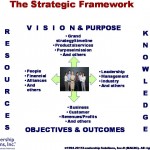| 21st Century Business Ideas |
by Peter A. Arthur-Smith, Leadership Solutions, Inc.® “Our business-organization planning season for 2016 is almost upon us, But the question is: ‘Is it really going to make a significant difference?’ Answer: Probably not Why?”
Strategic planning is still the year-end ritual for many enterprises as they aim to gain ground during their year ahead. Even though strategic planning’s real value has increasingly been questioned by leaders in the field., it persists as a ritual. Listen to Henry Mintzberg, a founding father of strategic planning, in his book ‘The Rise and Fall of Strategic Planning’ – “Strategic planning is an oxymoron. Strategy is about synthesis and planning is about analysis. It is impossible to do both at the same time.”
Strategic planning is primarily focused on two dimensions – imminent revenue goals and “making money.” If you’re a non-profit, it’s about donation revenues and breaking-even. In other words, strategic planning is almost exclusively focused on shareholder-owner or board member expectations. All other relevant constituents are brought into line to meet these two ends, but at a cost.
It’s a cost that comes from lack-luster motivation by organization personnel, as strategic planning invariably doesn’t excite company staff that much because they are largely excluded from the “plan.” This is likely to increase since our younger generations won’t be quite as anchored in revenue goals or making-money without additional desirable factors like: a valued purpose, beneficial human outcomes, and showing a valid societal contribution. Besides, the two traditional focus factors are only half the picture.
Along comes strategic positioning and its associated framework because they offer much more. Where strategic planning embodies planning, organizing, directing and controlling (PODC) to hit the desired revenue-profit objectives; strategic positioning embodies envisioning, positioning, engaging and collaborating (EPEC) to strike all stakeholder passions. Quite a difference?
Shareholders and owners love PODC because it speaks their language about “making money,” whereas most enterprise contributors-employees much prefer EPEC because it addresses considerably more of their expectations. The question is: Who produces the revenues and the profits?
We know that the shareholders-owners put up the initial capital, on the condition that they will make a healthy return-on-their-investment. Next question: Which comes first the chicken or the egg? Shareholder-owner equity is their part of the chicken: the rest of the chicken represents the people who make it grow and mature into an egg-laying machine.
Those “people” are much more interested in EPEC: Envisioning = building an amazing future; Positioning = making “us” well situated to succeed; Engaging= a place where “we” feel excited to give of our best; Collaborating= winning the full support of all external and internal constituents. Consequently, enterprises need a combination of PODC-strategic planning- and EPEC-strategic positioning. The more it is tilted toward the latter, the more the organization players will step-up their performance. The more staff and others step-up, the more money and revenues are generated.
Strategic frameworks now enter our picture because they bring the four dimensions our chicken-growers are intrinsically attracted to: a compelling Vision-Purpose; inspiring Objectives-Outcomes; vital Know-how; and essential Resources(VOKR). Compare these to our two traditional focus areas: revenues and profits (R & P). If an enterprise maximizes VOKR, it will make all the money its market will bear.
With just R & P, it will miss out on a lot. Let’s understand why, through the following thoughts:
» Compelling Vision-Purpose – To be compelling these have to resonate in a powerful way to both shareholder-owners and contributors-staff…the latter alludes to all those who crank the chicken to lay golden eggs. Current and future contributors-staff will be looking for EPEC, along with their financial rewards and benefits, to inspire them to maximize their contribution.
Purpose-driven situations like: “Our drug will raise life expectancy by 30%;” or “Our restaurant will give diners an exceptional social experience;” have far greater staff appeal than, “We will present shareholders with an increase in profits.” Besides, if you ‘increase life expectancy by 30%’ or give ‘restaurant guests an exceptional social experience,’ and actually live up to both, your “money-making” will be exceptional, too. In the case of non-profits, “Our non-profit will house 25% more homeless people.’ Doing this generates the donations and drive for breakeven.
» Inspiring Objectives-Outcomes – Objectives or priorities have to reflect the expectations of contributors-staff as well as the shareholders-owners-board members. Seeing the prospect of more jobs, promotion possibilities, decision participation, empowering assignments, greater learning, increased camaraderie, better ways to meet customer-client expectations, profit-sharing, and so on, is way more inspiring for your people.
When it comes to outcomes, shareholders-owners-board members expect higher revenues and profits. But their contributors-staff look for making customers smile, giving clients an exceptional experience, seeing their colleagues inspired, experiencing greater team-work, collaborating in educational sessions, shaping the purpose of the organization – all are people outcomes. The best enterprises meet the expectations of all those involved.
» Vital Know-how – Any listing is usually extensive: all the way from industry knowledge – to specialist know-how – to market knowledge – to business-building knowhow – operations expertise – and many other factors. Experience shows that many listings can be 15+ items; multiple enterprises are intuitively aware of them but they have never been formalized.
Once these factors are in the open, contributors-staff can help to prioritize and capitalize on known strengths; and work in teams to upgrade others where necessary. Most important, the listing encompasses all those things its leaders, specialists and staff need to know in order to accomplish their compelling vision-purpose and inspiring objectives-outcomes.
» Essential Resources – Again, a much more extensive resource listing than enterprises typically think about should be put together for supporting any framework effort. It will include such things as numbers of competent leaders-managers, effective specialist and staff members, finance, facilities, expert advisors, IT capabilities, and so on. Experience, again, shows this listing will go way beyond what organizations normally think about, especially when they are primarily focused on shareholder-owner interests.
No wonder so many organizations fall short on resources needed as they try to ramp up their enterprises, since they’ve usually only thought about half of what’s required. All the indications are that our younger generations are not inspired by traditional organizational methods. Many seasoned executives complain about the lack of interest and commitment from the Gen Ys, Gen Xs and Centennials.
Most younger people this author knows can be inspired by the right message and involvement, just as much as prior generations. They continue to break all sorts of records in amazing ways in sports, arts, business and other recreational fields. Young performers and dancers at Broadway shows, attended by this author, are just as invigorating as prior generations…in some cases even more so.
Again, it’s more a question of how we latch onto their inspiration and commitment? They are our future. We have to offer them environments that are strategically well positioned, and give them strategic frameworks that address their expectations just as much as the shareholder-owner-board members. Our days of worker-robots in command-and-control environments are over. Enter the age of Enlightened Leadership and purpose-driven cultures.
So, if you’re looking for a better than expected 2016, move beyond traditional planning – not discard it -and embrace better tools like strategic positioning with a compelling strategic framework. Leadership Solutions will always provide further enlightenment on such tools, where requested.
To learn more about Strategic Positioning and Frameworks, talk with:


